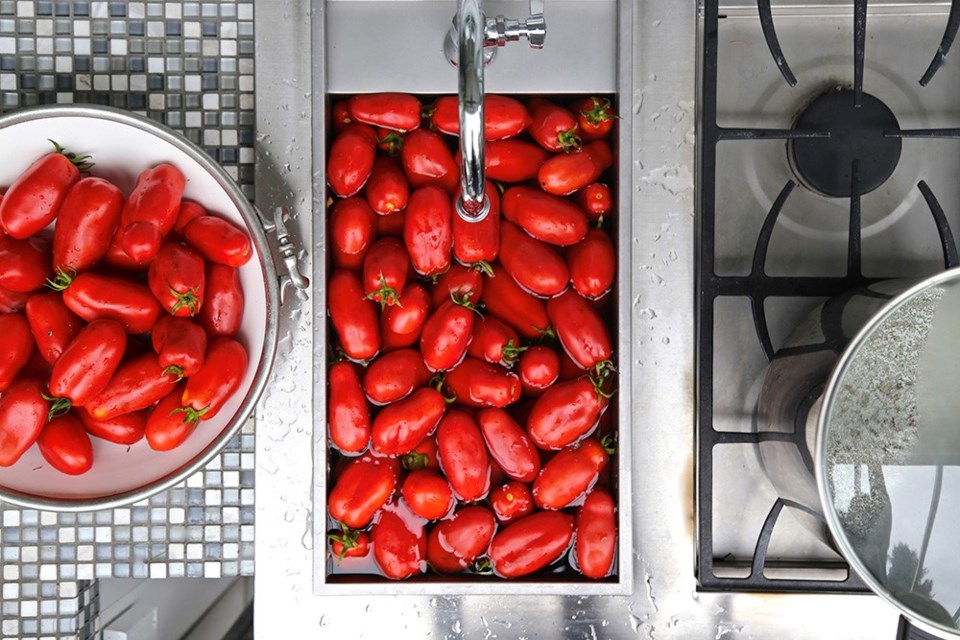There is still time to plant love apples — those gorgeous and voluptuous fruits (botanically speaking) that are foundational to many gardens and kitchens.
Several times each week, we incorporate home-grown and home-preserved tomatoes in recipes like spicy North African shakshuka, seafood paella, black bean chili, cold and hot soups, sauces, braises, sandwiches, dips, condiments, even tomato basil ice cream.
During the cold dark of winter, I menu plan the garden according to favourite family recipes, milestone events, and holiday gifting. Always, tomato seeds or seedlings are first on my wish list for ordering.
This year, I started many varieties of tomato and pepper seeds indoors on St. Valentine’s Day. My home office became grow-op central, with shelving and lights, seed trays, heat mats, worm castings (poop), fans, black-out cloth, waterers, misters, timers, and thermo-hygrometers. The undertaking was fun and informative, but for certain next year, the op moves into the garage.
At the top of my list of fave toms is Sungold. These bright orange, cherry-sized bombs of sweet candied sunshine, plus other favourites, produce volumes of fruit from late June through to November. I happily harvest, prepare and gift tomatoes throughout the season, growing plenty enough for cooking, small-batch canning, preserving and drying. For bulk canning crushed tomatoes, or for making sauce for freezing, I buy cases of Romas, plums or San Marzanos from farm stands or a farmers’ market.
Because our growing season has become unpredictable, with major rain events and extended damp threatening tomato health, I now grow many varieties in raised beds on our southwest-facing courtyard patio, under a high glass roof. The area is a “heat sink," capturing and storing solar energy by day and trickling it out slowly by night. The stone pavers, raised beds (galvanized steel livestock water tanks), stone water fountain, and other large, dense objects of considerable mass act like solar batteries. If I place my hand on any of these surfaces at 3 a.m. I can still feel the heat of the previous day. The house radiates heat as well, trapping warmth from the northeast, between the glass roof and the pavers – in effect, an open-sided greenhouse.
This same “heat sink” affect is easy to achieve in principle by placing tomato plants or planters against a sunny wall, under the eave of a house, or in pots in a doorway or other covered area. Small potted dwarf and tumbling tomatoes do well placed in sheltered but sunny areas such as on an outdoor table under a light-coloured umbrella, in an up-ended and open-sided crate, or under a tree. I’ve grown Sungolds and other indeterminate, vining type tomatoes against our cedar fence which provides both reflected and radiant heat, and a surface for running cheap and cheerful trellis lines using sisal string and eye hooks. This year I am growing peas, beans and Heavenly Blue morning glory on the sisal, but next year I will try trial new tomatoes.
To avoid attracting bears, raccoons and other wild neighbours, I harvest tomatoes and all other fruits "just" before fully ripe. My Friday ritual is to halve three to six litres (quarts) of cherry tomatoes, toss them in garlic olive oil with a pinch each of sea salt and Calabrian chili flakes, and then slow-roast them in a 120 °C (250 °F) oven for two or three hours until juicy-plump-chewy. The finished tomatoes and their gorgeous juices are portioned in 250ml (1 cup) deli containers, topped with more olive oil and herbs, then frozen for use in hundreds of recipes.
I manage surplus tomatoes by making a beautifully spiced roast fennel, tomato, peppers and garlic catsup that kids love. Tomato skins can be dehydrated and salted, to serve as chips or for garnish. At season’s end, unripe green tomatoes are brought indoors and either placed in brown paper bags to ripen in their own off-gasses, or made into green tomato and apple chutney. Nothing wasted.
Tomato plants are still available in garden centres, and the weather is improving, so, if you haven’t yet potted or planted tomatoes, why not give it a go? If you do, please send photos.
Laura Marie Neubert is a West Vancouver-based urban permaculture designer. Follow her on Instagram @upfrontandbeautiful, learn more about permaculture by visiting her Upfront & Beautiful website or email your questions to her here.
For a taste of permaculture, click on the YouTube link below:
(Video - Courtesy of West Vancouver Memorial Library)



